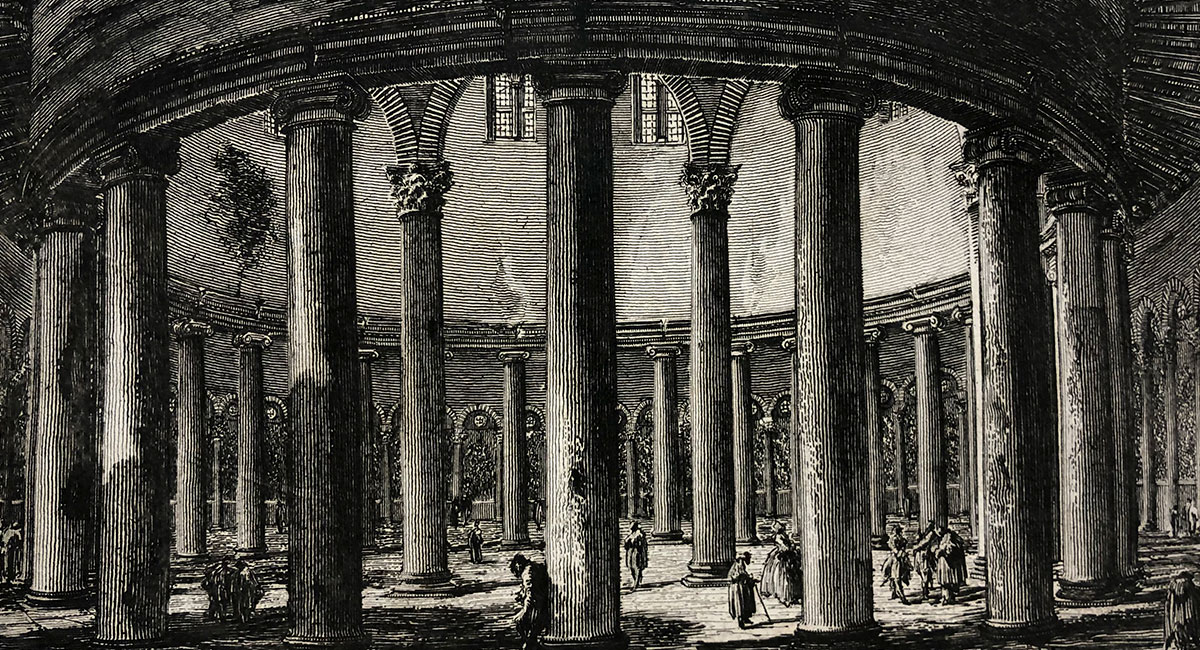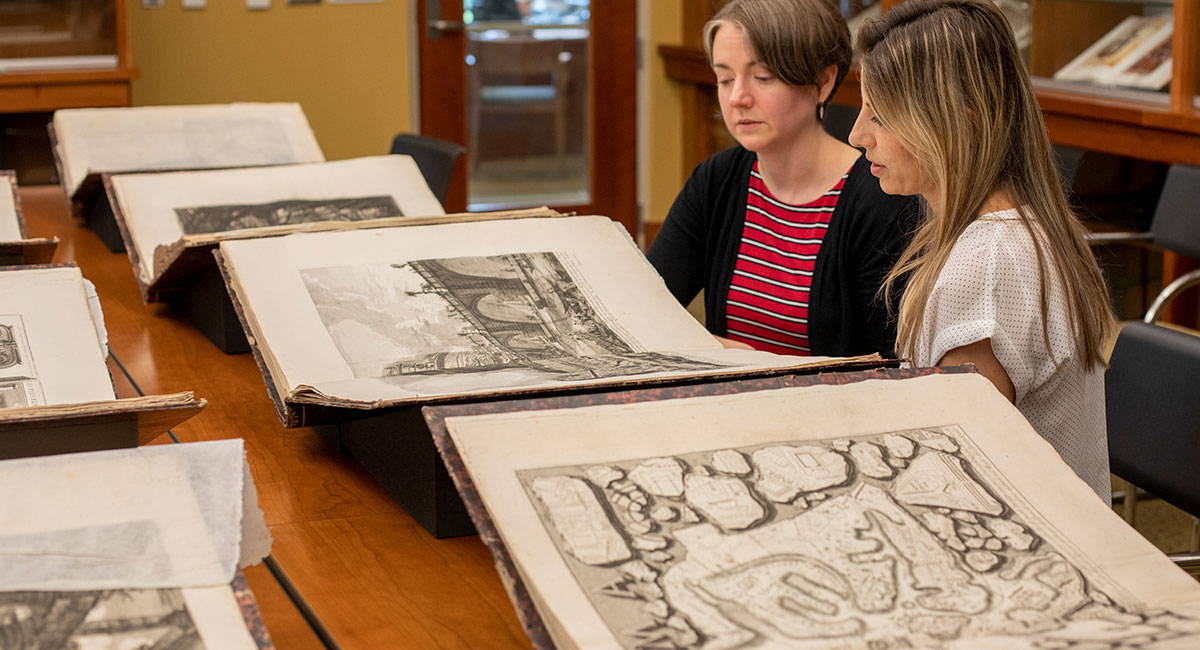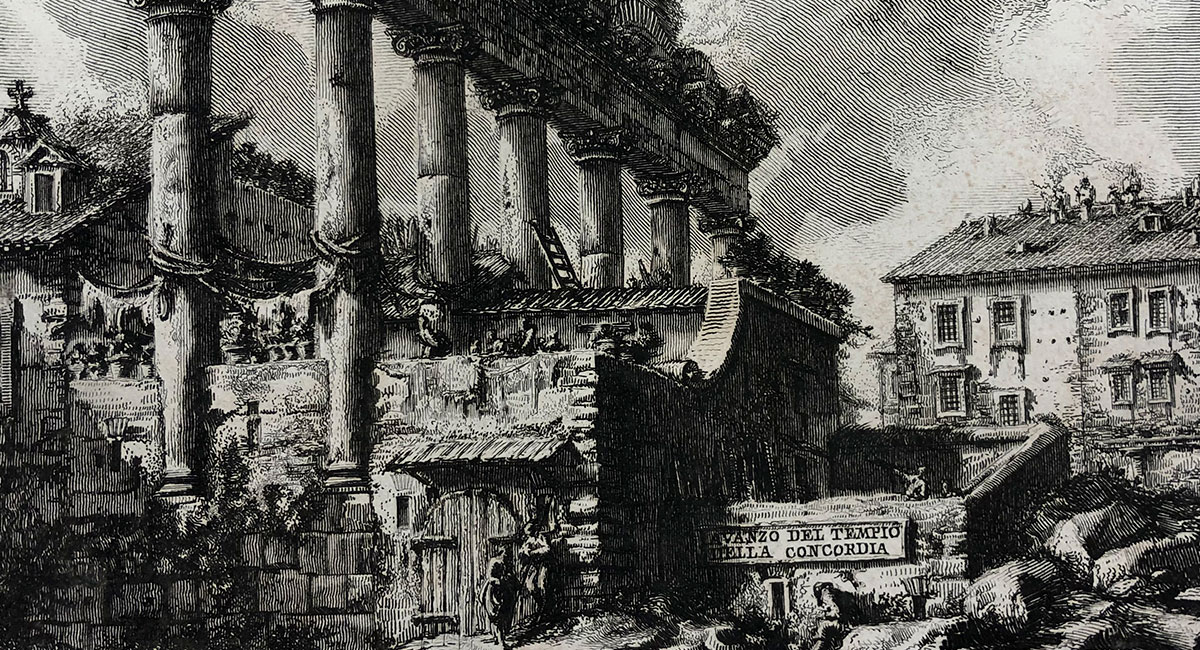Vive Piranesi
UofSC digitizes illustrations by innovative, enigmatic 18th-century artist
Posted on: October 21, 2020; Updated on: October 21, 2020
By Carol J.G. Ward, ward8@mailbox.sc.edu, 803-777-7549
Detail. Obsessive detail.
That’s the first description you get when you ask those familiar with Giovanni Piranesi about his artwork.
Obsessive detail can be seen throughout the 18th-century Italian illustrator’s works from the painstaking drawing of acanthus leaves on a Corinthian column to the shading on a beam of light streaming into a ruined building. It can be seen in all manner of ropes and chains and pulleys in a series of imaginary prisons and the numerous notations, indices, references and cross references that appear in his architectural etchings. So obsessive was his focus on Trajan’s Column in Rome that an entire volume of his work is devoted to it.
There’s often a combination of text and image in his etchings, which were produced from engravings on copper plates. In most cases, his notes and textual keys include factual information such as the circumference of a column or details about historic restoration. In other cases, Piranesi’s notes resemble lengthy essays on aesthetics and the role of the artist.
“Piranesi is inviting but also challenging. The pictures are so beautiful but also inaccessible and difficult to navigate in ways that I think he was very well aware of,” says Jeanne Britton, curator at the University of South Carolina’s Irvin Department of Rare Books and Special Collections. “I think he wanted to challenge his viewers, but one of the consequences is that his works aren’t as studied as they deserve to be.”
To make Piranesi (1720-78) more user-friendly, Britton is leading a project called "The Digital Piranesi," which aims to make this rare material accessible in an enhanced, interactive digital collection and make it visible, legible and searchable in ways that the original works are not.
The project was inspired by Britton’s personal affinity for Piranesi but more importantly by University Libraries’ rare complete set of his works, the Opere, held by fewer than 10 institutions in the world. Published in the 1830s after Piranesi’s death, the 29 elephant-folio volumes assemble all of his individual publications and include more than 1,000 images printed from the original engraved copper plates. Although there is no documentation about the university's acquisition of the Piranesi volumes, Britton has found evidence it was sometime between their publication and the 1870s.
“Aside from being included in a few library exhibits over the years, the volumes have rarely been used. We have this amazing complete set, and I started to think about how to make it accessible for researchers, art historians and anyone interested in Piranesi,” Britton says.
All of the volumes were scanned in University Libraries’ Digital Collections at very high resolution and are online in a digital collection, but Britton had a larger vision. She applied for and received a grant from the National Endowment for the Humanities to build "The Digital Piranesi," an interactive website that will digitally represent not only Piranesi’s images but also their interconnections, composite layers and verbal references through the use of hyperlinks and searchable data. The project also aims to provide translations of Piranesi’s texts, which include Italian as well as Latin, French and Greek. It’s the only digital collection of its kind in the world.

The original 'Where's Waldo?'
Britton and her collaborator Mike Gavin, associate professor in English who is the co-PI on the project, partnered with the university’s Center for Digital Humanities after receiving an ASPIRE-II grant in 2017 to begin work on "The Digital Piranesi," which is being built by students who work there with the support of the NEH grant.
“Piranesi’s work is like the original Where’s Waldo?," says Jason Porter, former business manager for the center. “There so much information hidden within each engraving that you constantly find new details every time you look at the material. If only people knew more about Piranesi, they would just dive in. Once people see it, they usually say, ‘This is super cool; I want to learn more.’ ‘The Digital Piranesi’ aims to make it easier for people to have that initial first impression.”
The way Piranesi combines image and text is innovative and obsessive. Some images and maps have numerical references in them, but the key may be many pages away. Unless a viewer knows to go back and forth across unnumbered pages in multiple volumes — from picture to map to index — they may appear to be just random numbers.
Porter, now in the School of Journalism and Mass Communications, has continued as an advisor on "The Digital Piranesi" because he says the project shows what can be accomplished through digital humanities. The innovative use of technology to archive and search his works is making Piranesi’s complex references and annotations more accessible and manageable.
“This isn’t just a set of illustrations. It is an interface. He didn’t just want to give us a beautiful image; he wanted to guide us through it,” Britton says. “Through the digital collection, we can be creative with Piranesi’s images but in ways that are authentic to his vision.”
The NEH grant also supports a postdoctoral fellow, Zoe Langer, who has been working on the project for a year, interpreting Piranesi’s works through scholarly essays, English translations, collaborating with students and faculty, and co-curating the exhibition “Piranesi’s Worlds: Mapping the Architectural Imagination.” Langer is excited about her role in making the artist accessible to a wider community of scholars and students so that they can directly engage with his works, perhaps for the very first time.
“The Digital Piranesi presents an amazing opportunity to work on the forefront of digital scholarship, to not only think about Piranesi’s works in different ways, but also to take the discipline of art history in exciting new directions,” she says. “Translating Piranesi’s prints — visually through digital tools and linguistically into English — has given us insights into his words, images, methods and intellectual approach and into 18th-century Italian culture.”

'There's always more to discover'
The high-resolution scans are already leading to new interactions with Piranesi’s work and fostering new research. Helen B.K. Marodin, a doctoral student in Latin American history, used them as she was writing her art history master’s thesis on Piranesi’s imaginary prisons, a series of etchings he published in 1749 and republished in 1761. Piranesi has intrigued her since she was studying for an architecture degree about 15 years ago. She was astonished that UofSC holds his complete works and says that the scans allowed her to zoom in on specific areas of the illustrations and see details that she couldn’t make out on the physical pages — even with a magnifying glass.
The imaginary prisons, 16 etchings of nightmarish spaces with dungeons and endless staircases, differ from Piranesi’s other drawings in style. Whereas the majority of Piranesi’s work is meticulously precise, the imaginary prisons look randomly spontaneous, which led to some misreading of the work. Marodin used her thesis to argue that these images weren’t an outlier born of madness or a fevered fit as many have suggested, but that they, in fact, are part of Piranesi’s intellectual postulations seen in following written works.
“The prisons show how bold and creative and versatile he was — his ability to draw both this kind of work that at least looks spontaneous and more expressive and his other work that is more precise,” Marodin says. “My thesis was based on what Piranesi was trying to say with these images. There are a lot of messages hidden in his shapes and in his forms. It’s one way of criticizing Roman society without being discovered, so he was wisely hiding himself inside the ambiguity of these images.”
For her, Piranesi has always provoked an emotional reaction whether it’s fear or admiration or because his artwork is beautiful yet also enigmatic and strange. Even though Marodin is currently pursuing other academic interests, she says she would love to keep working with Piranesi: “He has so many layers in his etchings; there's always more to discover.”

'A grand project'
That immersive quality that almost forcefully pulls viewers into his images makes Piranesi appealing even to those who are unfamiliar with him. Porter tells the story of two students from Benedict College who happened to be visiting the Hollings Special Collections Library while he and Britton were examining volumes from the Opere.
“They’d never heard of Piranesi, but they loved the depth of the drawings, even comparing the exaggerated architectural proportions to how we embellish our own social media presence. We spent 20 minutes going through these books with these two students,” Porter says. “There is so much within Piranesi that is relatable when people have access to it. We, along with Evan Meaney (associate professor in media arts), are working on a new project that will allow interaction with the work that is even more immersive and accessible.”
Britton, Porter and Meaney were awarded an ASPIRE-II grant for 2020-21 to fund that project, “The Virtual Pantheon,” an interactive virtual reality experience which takes viewers into Piranesi’s etchings to explorable within a multi-user virtual space. It is being created with open-source 3D computer graphics software within a video game engine using high-resolution scans of his images as well as digital scans of the Pantheon itself to build an immersive experience that allows a viewer to put on a VR headset and explore. Students at the Center for Digital Humanities built a beta version, which was used to secure funding, while lead VR developer, Patrick Nugent, ’09 media arts, is leading a small team in its current iteration.
Diem Dao, a senior majoring in computer information systems with a minor in business management, has worked on both “The Digital Piranesi” and “The Virtual Pantheon.” She was drawn to the project because she appreciates the way Piranesi challenges the viewer’s perspective and the work gives her an opportunity to combine her skills in art and technology.
“It’s really cool to build an environment where you can travel back in time and experience the style of an artwork,” Dao says. “This shows how you can use technology for entertainment and fantasy.”
Michael Whitehead, a 2019 graduate in computer science with a minor in media arts, also works on the project. Whitehead has continued after graduating because he believes that a first-person view of Piranesi’s interpretation of the Pantheon will give the general public – not just scholars – an opportunity to both enjoy and learn about what he calls the artist’s “fantastical and wondrous representation of architecture.”
The VR project will allow the viewer to step into Piranesi’s world transformed through the use of imagination. Porter sees opportunities to enhance the experience by partnering with other schools and disciplines on campus. For example, the School of Music or the experimental sound program in media arts could be enlisted to create a historically accurate soundscape or the dance department could capture 3D motions and movements to bring people in the drawings to life.
Britton, too, would like to expand and grow creative applications for Piranesi’s work if further funding becomes available. She floated the idea of a video game based on his etchings that feature crypts, tombs, skeletons, grave robbers and well-to-do 18th-century men walking around with torches.
“I think Piranesi was trying to present a view of Rome that is also a view of history and the development of art. It’s a grand project that needs lots of little pieces, and a lot of those pieces have been lost. We have all of the pieces here, and I’m really excited about being able to put them back together in different ways,” Britton says. “I want our project to do him justice — all his craziness and all his obsessiveness.”
Learn more
To commemorate the tricentennial of Giovanni Battista Piranesi's birth on Oct. 4, 1720, the Digital Piranesi at the University of South Carolina is hosting a free virtual lecture series. For a Zoom link, RSVP to jbritton@mailbox.sc.edu.
- 2 p.m. Nov. 12: “The Complete Piranesi” — Carolyn Yerkes, professor of art and archaeology at Princeton University
- 2 p.m. Dec. 3: “The Principle of Aesthetic Disinterest: Giovanni Battista Piranesi and the Lisbon Earthquake of 1755” — Peter Parshall, former curator, Old Master Prints, National Gallery of Art
In addition, a large exhibit devoted to Piranesi’s works and the digital projects in the Hollings Special Collections Library is planned for January 2021.